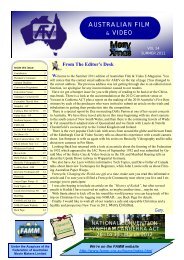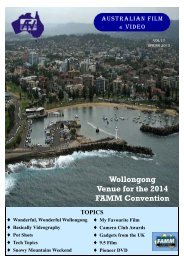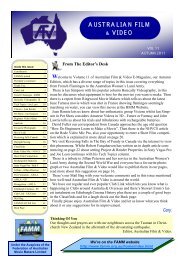20 AFV Winter 2013.pub - Federation of Australian Movie Makers
20 AFV Winter 2013.pub - Federation of Australian Movie Makers
20 AFV Winter 2013.pub - Federation of Australian Movie Makers
Create successful ePaper yourself
Turn your PDF publications into a flip-book with our unique Google optimized e-Paper software.
close-in will work well. Monitor the audio capture via headphones. That's not complicated. Take a video feed fromthe camera to either a family room monitor or a portable monitor. The cameraman and the director and the crew cansee what the camera sees. And it isn't difficult to set it up before the Shoot.“Break time” during the Shoot, sit around the camp-fire and play back what you've got so far. Quick c<strong>of</strong>fee or fruitjuice, a bag lunch. DO the re-shoots needed so far, there and then.If you have the luxury <strong>of</strong> a second camera for taking "cut-ins", the editor will bless you many times. Cut-ins provideextra information while the main action <strong>of</strong> the Show is proceeding. If you don't get them spontaneously, you can fakethem by taking them separately while the main camera gets ready for the continuation <strong>of</strong> the Shoot. And you can'thave too many cut-ins !RememberLeave plenty <strong>of</strong> "dead room" before each shot and at its conclusion. A "5 through to one, plus a hand signal." Actorsjust freeze for the "five-count" as the end <strong>of</strong> each take. . Before the actor speaks, it allows extra moments forthe actors to "psyche up." And, a refinement, if the Director wants to deploy L & J cuts (as cut-ins) these extraintroductory and concluding seconds may be handy. In a following shot, a character may begin responding to whatwas said in the prior shot and the left-over <strong>of</strong> the previous shot can "cover" his first few words. Variety and reaction.Nice touch. **At the "End" <strong>of</strong> the DayYou could plan on carrying the Shoot over to a second day, but a "carry-over" will produce "complications". So,gather everyone around the campfire with some munchies and a beverage and view "the rushes." together. The Directorwill decide on what shots will need re-doing. He has to possess a sixth-sense <strong>of</strong> how the shots will flow naturallyat the editing bench. Get the repeats done there and then is better than a "second day" attempt.What kind <strong>of</strong> a Narrative Works for youWell, a comedy should bring laughs from an empathetic audience. A short skit involving husband and wife, conflict& comedic resolution? Or a burst <strong>of</strong> Farce to begin with! A farce is deliberate exaggeration to the point <strong>of</strong> being ridiculous,but an audience may be coaxed to "willingly suspend disbelief" so it can enjoy the resulting comedy. Afarce is supposed to be funny; production mistakes may be forgiven more easily. An audience is less forgiving if theScreenplay tries to be "serious" and the actors aren't too convincing. The length <strong>of</strong> a "beginners' " screenplay couldfit nicely into 4-Minutes. It's a bigger challenge to keep actors and crew "on task" for a 10-Minutes longer "Drama."“Looking For Signs” [See video link.]My good wife, Joan, cooked up the "scenario", bearing in mind who she knew would become the acting talent. Sherefined it as we discussed the plot, its characterization, the strengths <strong>of</strong> our talent. Joan would accept the most difficultrole <strong>of</strong> a member <strong>of</strong> a Bridge Four - with her "signs <strong>of</strong> approaching dementia" . The actors' personas were defined.Our production sets were, (a) at the house entrance door and (b) at the kitchen snack table. One light to theceiling. All shots close-in, on-camera mikes, no room to fit in a tripod.Joan and I looked at possibilities for developing in this Screenplay a mixture <strong>of</strong> mild comedy and a touch <strong>of</strong> pathos -just a "touch" . The ending <strong>of</strong> the "play" suggests an aura <strong>of</strong> uncertainty. Does Joan have "approaching" dementia orsome other problem?Joan was the only member <strong>of</strong> the cast who'd had acting experience. She & I had plucked three ladies from our Seniors'Bridge Club who'd never been in a video "Shoot" in their lives, nor acted on stage. Using stage actors with experiencewould enable a faster Shoot.David Fuller**Cut-ins. Shot separately or as "L & J" Shots. Without cut-ins, the story becomes a "he said" and "she responded"thing. That's OK. But cut-ins can add extra emotional dimensions while the speaking actor is delivering her lines.You get images and input from two actors at the same time. In effect, you can fit extra information in the 4-Minutesslot.http://www.youtube.com/watch?v=PN6Mo9L_SXkAUSTRALIAN FILM & VIDEO—VOL <strong>20</strong> WINTER <strong>20</strong>13Page 31










